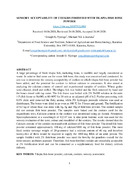| dc.description.abstract | A large percentage of fresh tilapia fish, including bone, is inedible and largely considered as waste. In order to find some use for waste fish bone, this study was conceived and conducted. Its aim was to determine the sensory acceptability of cookies to which tilapia fish bone powder has been added, and the potential for cookies to deliver calcium to consumers. It also aimed at
analyzing the calcium content of control and experimental samples of cookies. Wheat grains were cleaned, dried and milled. The tilapia fish was boiled and the flesh removed by hand and the bones rinsed with tap water. The fish frame was boiled with 2% NaOH solution in the ratio 1:5 (fish frame to NaOH) at 80-90ºC for 30 min at an adjusted pH of 6.2. Further processing with
0.1% citric acid removed the fishy aroma, while 5% hydrogen peroxide solution was used as disinfectant. The bones were dried in an oven at 100 ºC for 3 hours and ground. The fortification of 0.5 kg of wheat flour was done with 1g, 5g and 10g of fish bone powder. The control sample did not contain fish bone powder. The samples were baked and the cookies used for the
organoleptic tests. Calcium content in the cookies was determined using an Atomic Absorption Spectrophotometer at a wavelength of 422.67 nm. A nine-point hedonic scale was used for the sensory evaluation of the taste, colour and mouthfeel of the cookies. The results showed that the Calcium content of the cookies increased with addition of fish bone powder. The dried fish bone powder contained approximately 100 mg of calcium/1000 mg of fish bone powder. The most liked cookie (average weight of 20 grammes) had a calcium content of 40 mg and therefore twenty-five of them would be required to supply the 1000 mg RDA of an adult person. The sample fortified with 2% fish bone powder was rated the best by the panelists overall for the
three sensory attributes assessed. Therefore, fish bone fortified cookies are sensorially acceptable at 2% fortification level and can be consumed as a supplementary food for dietary calcium delivery. | en_US |
